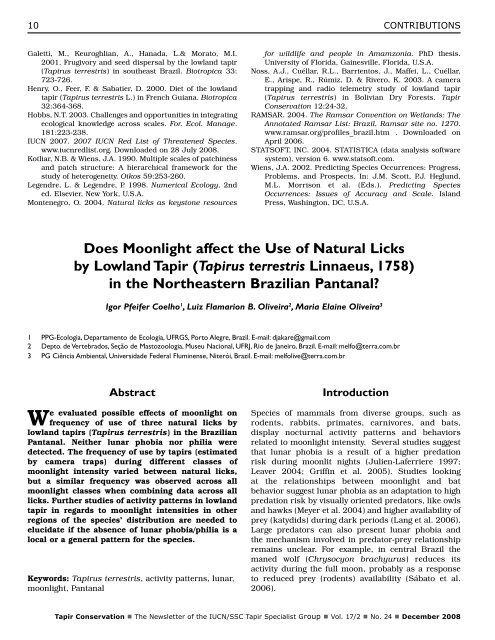Tapir Conservation - Tapir Specialist Group
Tapir Conservation - Tapir Specialist Group
Tapir Conservation - Tapir Specialist Group
Create successful ePaper yourself
Turn your PDF publications into a flip-book with our unique Google optimized e-Paper software.
10<br />
Galetti, M., Keuroghlian, A., Hanada, L.& Morato, M.I.<br />
2001. Frugivory and seed dispersal by the lowland tapir<br />
(<strong>Tapir</strong>us terrestris) in southeast Brazil. Biotropica 33:<br />
723-726.<br />
Henry, O., Feer, F. & Sabatier, D. 2000. Diet of the lowland<br />
tapir (<strong>Tapir</strong>us terrestris L.) in French Guiana. Biotropica<br />
32:364-368.<br />
Hobbs, N.T. 2003. Challenges and opportunities in integrating<br />
ecological knowledge across scales. For. Ecol. Manage.<br />
181:223-238.<br />
IUCN 2007. 2007 IUCN Red List of Threatened Species.<br />
www.iucnredlist.org. Downloaded on 28 July 2008.<br />
Kotliar, N.B. & Wiens, J.A. 1990. Multiple scales of patchiness<br />
and patch structure: A hierarchical framework for the<br />
study of heterogeneity. Oikos 59:253-260.<br />
Legendre, L. & Legendre, P. 1998. Numerical Ecology. 2nd<br />
ed. Elsevier, New York, U.S.A.<br />
Montenegro, O. 2004. Natural licks as keystone resources<br />
for wildlife and people in Amamzonia. PhD thesis.<br />
University of Florida, Gainesville, Florida, U.S.A.<br />
Noss, A.J., Cuéllar, R.L., Barrientos, J., Maffei, L., Cuéllar,<br />
E., Arispe, R., Rúmiz, D. & Rivero, K. 2003. A camera<br />
trapping and radio telemetry study of lowland tapir<br />
(<strong>Tapir</strong>us terrestris) in Bolivian Dry Forests. <strong>Tapir</strong><br />
<strong>Conservation</strong> 12:24-32.<br />
RAMSAR. 2004. The Ramsar Convention on Wetlands: The<br />
Annotated Ramsar List: Brazil, Ramsar site no. 1270.<br />
www.ramsar.org/profiles_brazil.htm . Downloaded on<br />
April 2006.<br />
STATSOFT, INC. 2004. STATISTICA (data analysis software<br />
system), version 6. www.statsoft.com.<br />
Wiens, J.A. 2002. Predicting Species Occurrences: Progress,<br />
Problems, and Prospects. In: J.M. Scott, P.J. Heglund,<br />
M.L. Morrison et al. (Eds.). Predicting Species<br />
Occurrences: Issues of Accuracy and Scale. Island<br />
Press, Washington, DC, U.S.A.<br />
Does Moonlight affect the Use of Natural Licks<br />
by Lowland <strong>Tapir</strong> (<strong>Tapir</strong>us terrestris Linnaeus, 1758)<br />
in the Northeastern Brazilian Pantanal?<br />
Igor Pfeifer Coelho 1 , Luiz Flamarion B. Oliveira 2 , Maria Elaine Oliveira 3<br />
1 PPG-Ecologia, Departamento de Ecologia, UFRGS, Porto Alegre, Brazil. E-mail: djakare@gmail.com<br />
2 Depto. de Vertebrados, Seção de Mastozoologia, Museu Nacional, UFRJ, Rio de Janeiro, Brazil. E-mail: melfo@terra.com.br<br />
3 PG Ciência Ambiental, Universidade Federal Fluminense, Niterói, Brazil. E-mail: melfolive@terra.com.br<br />
Abstract<br />
We evaluated possible effects of moonlight on<br />
frequency of use of three natural licks by<br />
lowland tapirs (<strong>Tapir</strong>us terrestris) in the Brazilian<br />
Pantanal. Neither lunar phobia nor philia were<br />
detected. The frequency of use by tapirs (estimated<br />
by camera traps) during different classes of<br />
moonlight intensity varied between natural licks,<br />
but a similar frequency was observed across all<br />
moonlight classes when combining data across all<br />
licks. Further studies of activity patterns in lowland<br />
tapir in regards to moonlight intensities in other<br />
regions of the species’ distribution are needed to<br />
elucidate if the absence of lunar phobia/philia is a<br />
local or a general pattern for the species.<br />
Keywords: <strong>Tapir</strong>us terrestris, activity patterns, lunar,<br />
moonlight, Pantanal<br />
Introduction<br />
CONTRIBUTIONS<br />
Species of mammals from diverse groups, such as<br />
rodents, rabbits, primates, carnivores, and bats,<br />
display nocturnal activity patterns and behaviors<br />
related to moonlight intensity. Several studies suggest<br />
that lunar phobia is a result of a higher predation<br />
risk during moonlit nights (Julien-Laferriere 1997;<br />
Leaver 2004; Griffin et al. 2005). Studies looking<br />
at the relationships between moonlight and bat<br />
behavior suggest lunar phobia as an adaptation to high<br />
predation risk by visually oriented predators, like owls<br />
and hawks (Meyer et al. 2004) and higher availability of<br />
prey (katydids) during dark periods (Lang et al. 2006).<br />
Large predators can also present lunar phobia and<br />
the mechanism involved in predator-prey relationship<br />
remains unclear. For example, in central Brazil the<br />
maned wolf (Chrysocyon brachyurus) reduces its<br />
activity during the full moon, probably as a response<br />
to reduced prey (rodents) availability (Sábato et al.<br />
2006).<br />
<strong>Tapir</strong> <strong>Conservation</strong> n The Newsletter of the IUCN/SSC <strong>Tapir</strong> <strong>Specialist</strong> <strong>Group</strong> n Vol. 17/2 n No. 24 n December 2008










